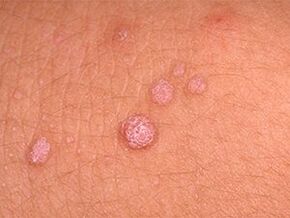Body papillomas are a common occurrence in dermatology practices.The main sites are the armpits, neck, groin and genitals, and face.The course of most tumors is benign, but under the influence of several negative factors, the risk of transformation into skin cancer or tumors at any other site increases.
Why are papillomas dangerous to humans?

Viral tumors in the body are usually caused by strains with a relatively low risk of carcinogenesis and minimal risk of cell degeneration.Due to cellular atypia, rapid growth and changes in architectural features of papillary lesions can be observed.
Today, particularly dangerous strains include HPV types 15, 16, 18, 35, 51-59, 66-68.Interestingly, the location of cancerous tumors during human papillomavirus infection can be absolutely anywhere.
Papillomas on the body appear as verrucous tumors, calluses, flat warts, or genital warts.The risks and complications caused by HPV often differ between men and women.
Complications of male papillomavirus
Typically, men become carriers of the infectious strain and transmit it to women through unprotected sexual contact.The main areas on the body where male papillomas occur are the genitals, genitals, frenulum, and foreskin; papillomas usually form in the male anus.Sometimes growths appear in the armpits and neck.
Symptoms depend directly on location.The clinical manifestations of papillomas located in the genitals are more typical.Often, tumors are not associated with obvious symptoms.
The main complications in men are:
- prostate cancer;
- laryngeal and laryngeal cancer;
- Impotence;
- infertility;
- erectile dysfunction;
- development of adenocarcinoma;
- Malignant intestinal tumors.
The following factors promote the transformation of healthy cells into cancer cells:
- bad habits,
- tough working conditions,
- often under pressure,
- Papillary lesions permanently damage;
- Not enough hygiene.
Dangerous Traits of Women
Without adequate treatment, HPV infection in women may lead to greater complications due to the unique anatomy and hormone levels of the reproductive organs.
The main complications are:
- cervical and adnexal cancer;
- Dysplasia of the vulva, vaginal vault, and cervical canal;
- Structural cancer of the uterus;
- If a papilloma is diagnosed in a woman's groin, she has large genital warts;
- Malignant changes in pharyngeal mucosa and reproductive organs;
- Genital skin warts according to the Lewandowski-Lutz pathological type;
- Esophageal and laryngeal cancer;
- Plantar cancer.
Warts and genital warts located within the urethral lumen can cause disruption of the flow of urine.When located in the larynx - hoarseness and impaired respiratory function.
Unfortunately, many women view any new growth on their skin solely as a cosmetic problem.By removing the papilloma, they hope to completely eliminate the HPV problem.When the viral infection is active, the removed tumors can reappear with greater intensity.
It is important to promptly identify signs of tumor malignancy:
- Changes in the shape, size, and structure of growths;
- The tone of papillary lesions is unstable:
- Pain in the growing area;
- Ongoing trauma, bleeding, infection.
Regular exposure to negative factors can lead to erratic growth and stimulate cells to transform into cancerous cells.
If papilloma occurs, it is recommended to consult a dermatologist to clarify the nature of the pathological rash.
Are papillomas on the body contagious?

Can papillomas on the body spread from person to person?Given the highly contagious nature of human papillomavirus infection, patients wonder whether it is possible to contract the virus through contact with viral tumor lesions on the skin.The answer is clear – it is almost impossible to “catch” the virus when exposed to a papilloma.
But if the skin between a carrier and a healthy person is damaged, the risk of infection increases.
There are other ways the infection is spread:
- sexual contact;
- labor activities;
- Household route of exposure (staying with someone with the virus for an extended period of time).
You can also become infected in public places, especially in bathrooms, saunas, locker rooms and swimming pools.
There is a concept of self-infection when one injured papilloma leads to many other papillomas over the entire surface of the body.
Just because the virus invades the human body does not mean that a rash will appear after a period of time.The human body's immune response is high, and the amount of antibodies is enough to inhibit the viral activity of any strain. In the context of good health, the virus will not appear at all until the end of life.
Of course, even if a person does not have any symptoms, he is still a carrier of the viral infection.
I have lots of papillomas on my body, what does it mean?
The appearance of papillomas in various parts of the body is characteristic of activation of viral strains.Multiple papilloma lesions indicate an increased risk of malignancy in the tumor.The increase in pathogenic activity of viral strains is due to ongoing and progressive decline in immunity.
The following factors may cause a decrease in the body's immune response:
- cold;
- low temperature;
- stress factors;
- alcohol and drug abuse;
- persistent hormonal imbalance;
- Pregnancy, miscarriage;
- Chronic disease of internal organs.
Simple failure to follow personal hygiene rules can trigger viral activity.From a somatic perspective, multiple papillomas may explain the pathology of internal organs and systems.HPV often co-occurs with other viral diseases, such as herpes infection.
Papillomas have spread throughout the body – what should I do?

When multiple papillomas are present, it is important to make a differential diagnosis.A medical professional will usually immediately notice the nature of the rash and point to a tumor as the possible cause.
The main research methods are:
- Blood tests for viral antibodies;
- The Digen test identifies strain type, viral structure and cancer risk;
- Polymerase chain reaction detects viral DNA;
- Cytological examination of biological material in the cervical canal;
- Histological examination of female reproductive organ samples;
- Analysis of warts or genital warts.
The initial diagnosis is usually made during the first examination of the patient.Viral infection is diagnosed or excluded based on the study results and the patient's clinical history.It is important to distinguish HPV from skin diseases, cancers and herpes viruses.
Fight Papillomas on the Body
There is currently no effective treatment for viral infections, but official medicine can create conditions for stable remission and prevention of rashes.The infection itself is not dangerous, but papilloma formation increases the risk of cellular malignancies and tumors.
treat
One promising direction is pharmacological treatment:
- interferon-based immunomodulators that stimulate the immune system;
- antiviral agents;
- Vitamins can enhance immunity and restore physical strength;
- Topical preparations for papilloma removal.
If secondary infection occurs, bacteriological treatment and antiseptic treatment are performed.
Non-steroidal anti-inflammatory drugs are suitable for pain relief.
move
Tumors can be removed with modern hardware technology and cosmetic surgery.
There are several effective methods of tumor removal:
- scalpel;
- laser;
- radio waves;
- freezing damage;
- Chemical;
- Electrocoagulation.
No surgery can prevent further development of pathological growth.Without adequate antiviral treatment, eliminating external symptoms can only have a temporary effect.
HPV is a common infection that can be contracted through sexual contact and frequent kissing.The main preventive measure is to vaccinate children aged 12-14 years before their first sexual experience.It is important to monitor skin and genital hygiene.Unfortunately, even barrier birth control methods do not guarantee 100% protection against human papillomavirus infection.The patient's prompt response to the rash is key to safe and rapid treatment, including preventing the risk of cancerous tumors.























